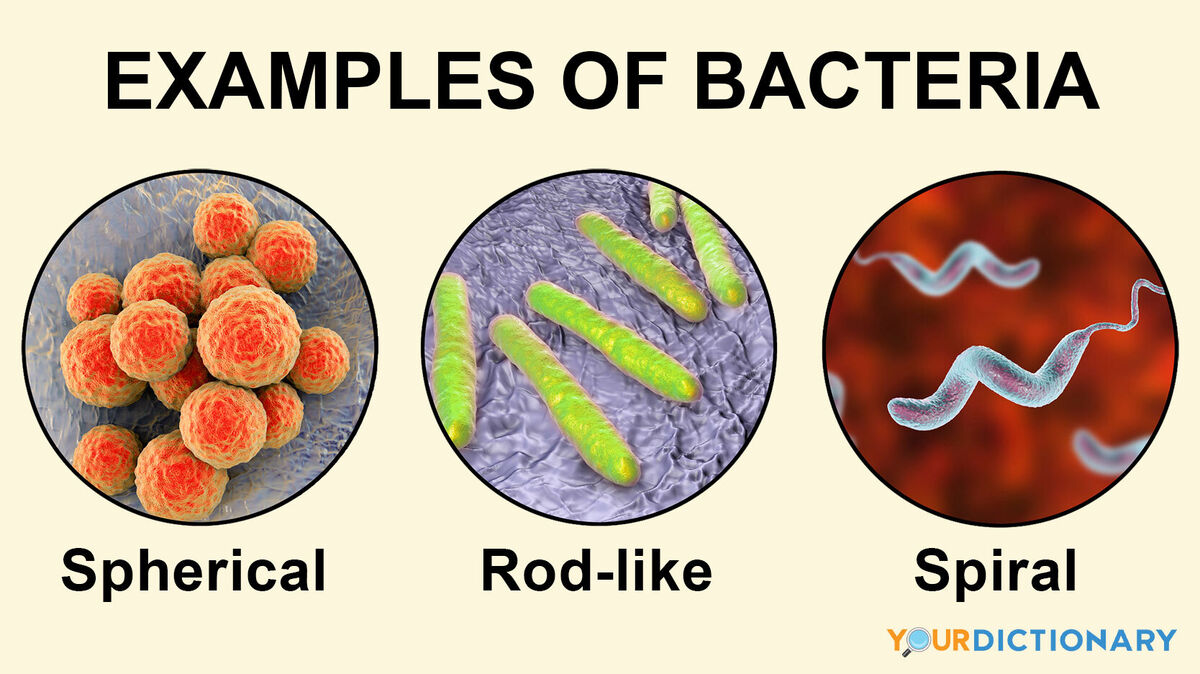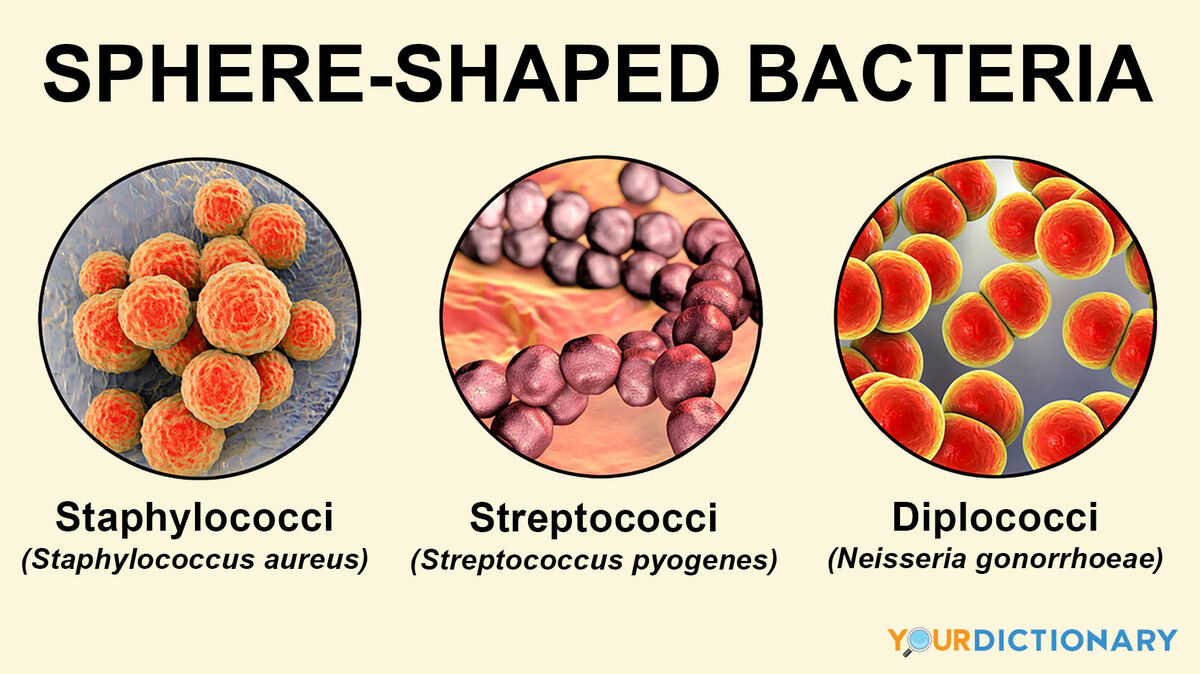
Bacteria are the plural of bacterium, which are microscopic one-celled organisms. They are found everywhere and can be harmful, as in bacterial infections, or they can be beneficial, as in fermentation or decomposition. The three main bacteria shapes are coccus, bacillus and spiral. Keep reading for examples of bacteria in each of these three types.
Sphere-Shaped Bacteria
Coccus bacteria, or cocci, are sphere or oval-shaped bacteria that grow in chains or clusters. They cause many bacterial infections in humans, including strep throat (Streptococcus pyogenes). However, some cocci are also helpful to humans, such as the bacteria that make up normal human skin flora (Staphylococcus epidermidis).
Cocci appear as single cells (coccus), pairs (diplococci), chains (streptococci), clusters of four cells (tetrads), irregular clusters (staphylococci), or large cuboid clusters (sarcinae).

Examples of sphere-shaped cocci include:
- Aerococcus urinae (causes urinary tract infections and urosepsis)
- Chlamydia trachomatis (causes sexually transmitted disease chlamydia)
- Enterococcus faecalis (causes tooth and intestinal infections)
- Fusobacterium necrophorum (causes Lemierre's syndrome)
- Fusobacterium nucleatum (causes periodontal disease)
- Moraxella catarrhalis (causes infections in the eye, nervous systems and joints)
- Neisseria gonorrhoeae (causes the sexually transmitted disease gonorrhea)
- Neisseria meningitidis (causes meningococcal disease)
- Pediococcus acidilactici (helpful gut bacteria)
- Pediococcus damnosus (found in fermented beverages and spoiled food)
- Sarcina ventriculi (found in soil with low pH)
- Sporosarcina ureae (found in soil with high amounts of urine)
- Sporosarcina aquimarina (found in sea water)
- Staphylococcus aureus (causes pneumonia and skin infections)
- Staphylococcus epidermidis (common part of normal skin flora)
- Staphylococcus haemolyticus (found in hospital staph infections)
- Staphylococcus saprophyticus (causes urinary tract infections)
- Streptococcus agalactiae (known as Group B streptococcus; causes serious bacterial infections in infants when passed from mothers during childbirth)
- Streptococcus bovis (found in sepsis and colorectal cancer)
- Streptococcus pneumoniae (causes pneumonia, meningitis and bronchitis)
- Streptococcus pyogenes (known as Group A streptococcus; causes tonsilitis, strep throat and cellulitis)
- Tetragenococcus halophilus (used when fermenting soy sauce and miso)
Rod-Shaped Bacteria
Bacillus is Latin for "stick," which describes the rod-like shape of this type of bacteria. Bacteria from the genus Bacillus are primarily found in soil and water, and the most well-known example is E. coli (Escherichia coli). Like cocci, they can be identified by arrangement: single cells (bacillus), pairs (diplobacilli) and chains (streptobacilli). Oval-shaped bacilli are known as coccobacili.

Examples of these rod-shaped bacteria include:
- Aeromonas hydrophila (causes traveler's diarrhea)
- Arcanobacterium bemolyticum (causes pharyngitis and sinusitis)
- Bacillus anthracis (causes anthrax; can be spread from animals to humans)
- Bacillus cereus (causes food poisoning)
- Bordetella pertussis (causes whooping cough)
- Capnocytophaga canimorsus (transmitted from dogs and cats; can cause bacterial infections in humans)
- Chlamydophila pneumoniae (causes bacterial pneumonia)
- Chlamydophila psittaci (causes psittacosis and pneumonia in humans when exposed to infected birds)
- Citrobacter freundii (found in healthy intestinal systems, but can cause serious infection when contaminated in other areas)
- Clostridium botulinum (causes botulism)
- Clostridium difficile (causes severe diarrhea and colitis)
- Clostridium tetani (causes tetanus)
- Corynebacterium diphtheriae (also known as Klebs-Löffler bacillus; causes diphtheria)
- Corynebacterium jeikeium (causes infection in bone marrow)
- Escherichia coli (found in soil and uncooked food; causes gastrointestinal illness)
- Halomonas elongata (found in saltwater)
- Klebsiella aerogenes (causes sepsis)
- Klebsiella pneumoniae (healthy gut bacteria that can contaminate lungs and cause serious infections)
- Legionella pneumophila (causes Legionnaire's disease)
- Listeria monocytogenes (found in raw milk and produce; causes listeria)
- Morganella morganii (healthy intestinal bacteria that cause hospital-acquired infections if contaminated)
- Mycobacterium leprae (causes leprosy)
- Mycobacterium tuberculosis (causes tuberculosis)
- Plesiomonas shigelloides (causes enteric disease when found in raw seafood)
- Prevotella intermedia (causes periodontal disease and gingivitis)
- Porphyromonas gingivalis (causes periodontitis)
- Propionibacterium acidipropionici (causes acne and other skin issues; used in the production of cheese and vitamin B12)
- Proteus vulgaris (found in the intestinal tract; causes wound and urinary tract infections)
- Providencia stuartii (causes urinary tract infections)
- Salmonella typhimurium (causes salmonellosis and intestinal infections)
- Serratia marcescens (causes wound infections and pneumonia)
- Vibrio cholerae (causes cholera)
- Vibrio parahaemolyticus (found in contaminated saltwater or seafood from contaminated water; causes gastrointestinal illness)
- Vibrio vulificans (causes gastroenteritis, dermatitis and severe sepsis)
Rod-Shaped Bacteria That Ferment Food
While some rod-shaped bacteria can make you very sick, other types can bring your food to the perfect ripeness. Take a look at these bacteria examples that ripen and ferment your food.
- Acetobacter aceti (converts ethanol to acetic acid and works in sugar fermentation)
- Arthrobacter nicotianae (grown with cane or beet molasses)
- Arthrobacter arilaitensis (found on the surfaces of smear-ripened cheeses)
- Bifidobacterium adolescentis (healthy gut bacteria found in babies)
- Brachybacterium tyrofermentans (works in cheese fermentation)
- Brevibacterium linens (causes foot odor on human skin; ferments mold-ripened cheeses)
- Carnobacterium divergens (found in spoiled meat and dairy products)
- Gluconobacter oxydans (causes rot in fruits and vegetables)
- Hafnia alvei (used as a probiotic in dairy supplement products)
- Lactobacillus acetotolerans (found in rice wine vinegar)
- Lactobacillus acidifarinae (used in sourdough bread starters)
- Lactobacillus helveticus (used in cheese-making)
- Lactococcus lactis (used to make buttermilk and other dairy products)
- Pseudomonas fluorescens (causes milk to spoil and coagulate)
- Weissella koreensis (found in kimchi)
- Zymomonas mobilis (found in wine and beer spoilage)
Rickettsia Examples
Bacteria from the genus Rickettsia are primarily rod-shaped, though some can be spherical like cocci. Rickettsia bacteria are transmitted by regional parasites, such as lice, ticks or fleas. They behave like viruses and can't live outside living cells.
Examples of Rickettsia bacteria include:
- Rickettsia akari (transmitted by mites; causes rickettsialpox)
- Rickettsia conorii (transmitted by ticks; causes boutonneuse fever, spotted fever and tick typhus)
- Rickettsia felis (transmitted by fleas; causes spotted fever)
- Rickettsia prowazekii (transmitted by lice; causes louse-borne typhus)
- Rickettsia rickettsii (transmitted by ticks; causes Rocky Mountain spotted fever)
- Rickettsia typhi (transmitted by rat fleas; causes typhus)
Spiral-Shaped Bacteria
Spiral-shaped bacteria are primarily found in standing water. Like Rickettsia bacteria, some types of spiral bacteria are carried by ticks. They typically appear in two main forms: long, rigid spirals (spirilla) and thin, flexible spirals (spirochetes). Take a look at these examples of bacteria in spiral shapes.

- Borrelia afzelii (causes Lyme disease)
- Borrelia burgdorferi (causes Lyme disease)
- Borrelia hermsii (causes relapsing fever)
- Campylobacter coli (causes campylobacteriosis and foodborne illness)
- Campylobacter jejuni (most common cause of food poisoning)
- Campylobacter rectus (causes periodontitis)
- Helicobacter hepaticus (found in cases of hepatitis and colorectal cancer)
- Helicobacter pylori (causes stomach ulcers)
- Leptospira interrogans (causes leptospirosis and Weil's syndrome)
- Spirillum minus (believed to cause rat-bite fever)
- Spirillum volutans (found in freshwater)
- Spirillum winogradskyi (found in wastewater)
- Treponema pallidum (causes syphilis)
- Treponema carateum (causes pinta, an African skin disease)
- Treponema denticola (causes chronic periodontitis)
Mycoplasma Bacteria
Some bacteria have no cell walls, which makes it difficult to classify their shapes as spherical, rod-shaped or spiral. Mycoplasma bacteria are resistant to many antibiotics due to their lack of cell walls, and are the smallest form of bacterial cells.
Examples of mycoplasmas include:
- Mycoplasma fermentans (causes respiratory and rheumatoid diseases)
- Mycoplasma gallisepticum (causes chronic respiratory disease in humans and animals - primarily birds)
- Mycoplasma genitalium (causes urethritis and pelvic inflammatory disease)
- Mycoplasma haemofelis (causes blood infections in cats)
- Mycoplasma hominis (causes bacterial vaginosis)
- Mycoplasma hyopneumoniae (causes pneumonia in pigs)
- Mycoplasma incognitus (breaks down the immune system; can be a disease agent for HIV and Parkinson's Disease)
- Mycoplasma penetrans (appears in people with immunodeficiencies; causes pelvic inflammatory disease)
- Mycoplasma pneumoniae (causes mild "walking" pneumonia)
- Mycoplasma salivarium (found in healthy mouths and oral flora)
Living in Balance With Bacteria
Now you have seen lots of different examples of bacteria, the types of bacteria and some of the things that bacteria can do. If you're interested in learning more about common bacteria, take a look at these five common eubacteria examples. Or, if you want to prevent some of these bacterial infections, try out these tips on how to kill household germs and bacteria. From there, explore some more fun facts about bacteria.